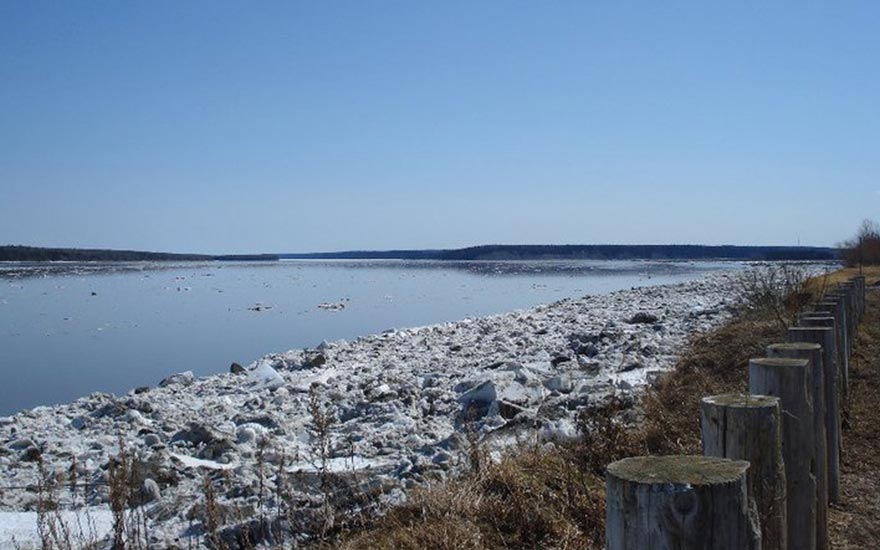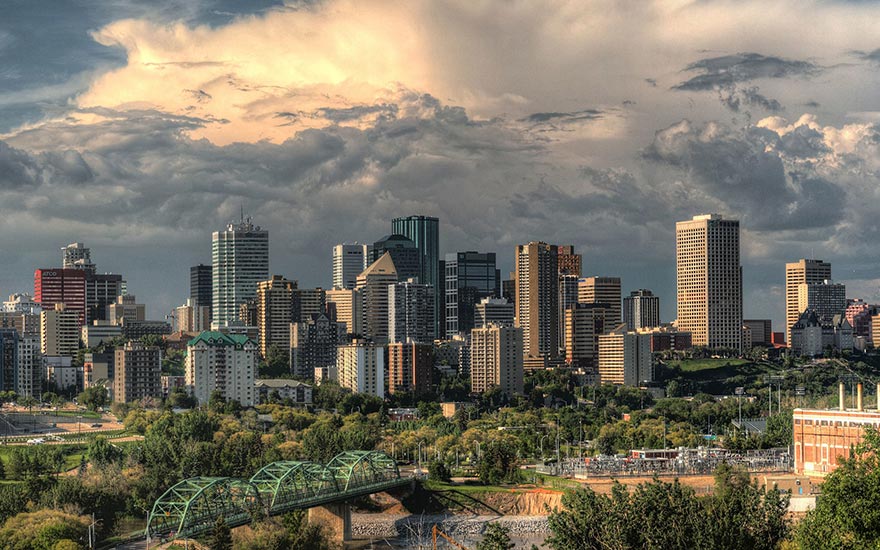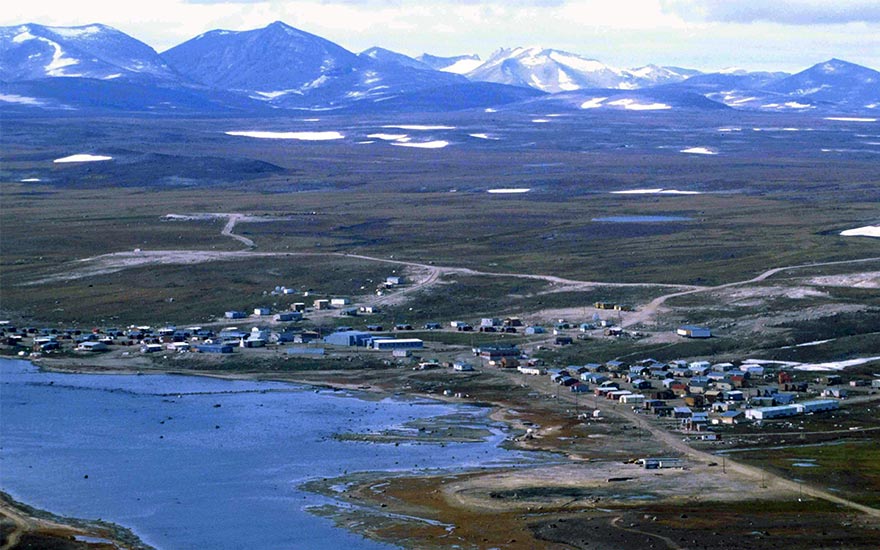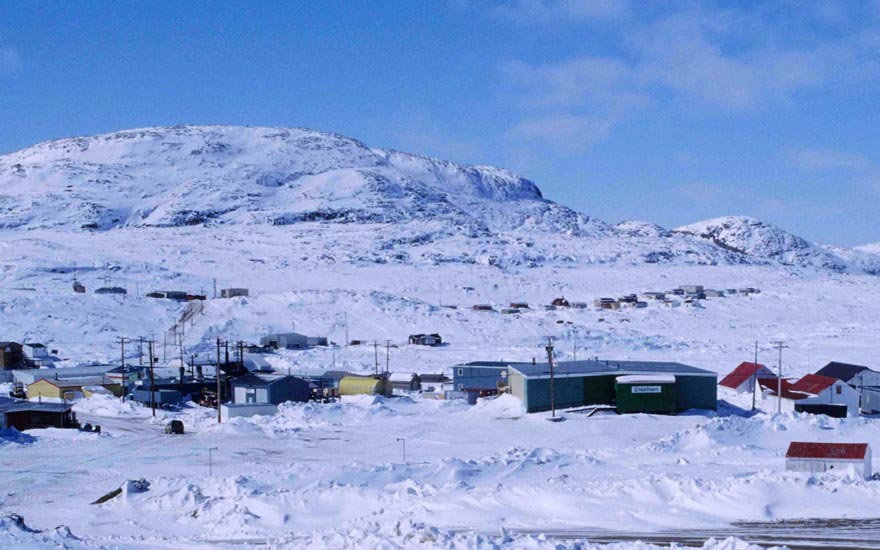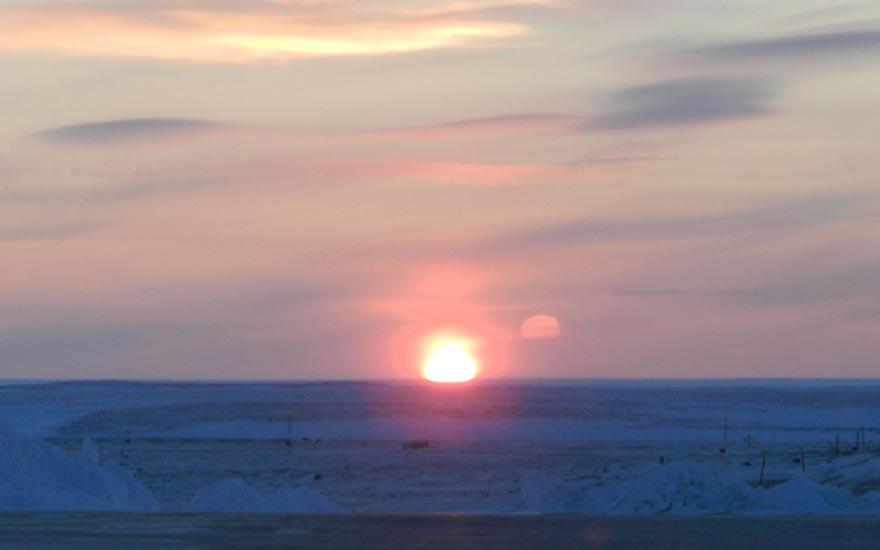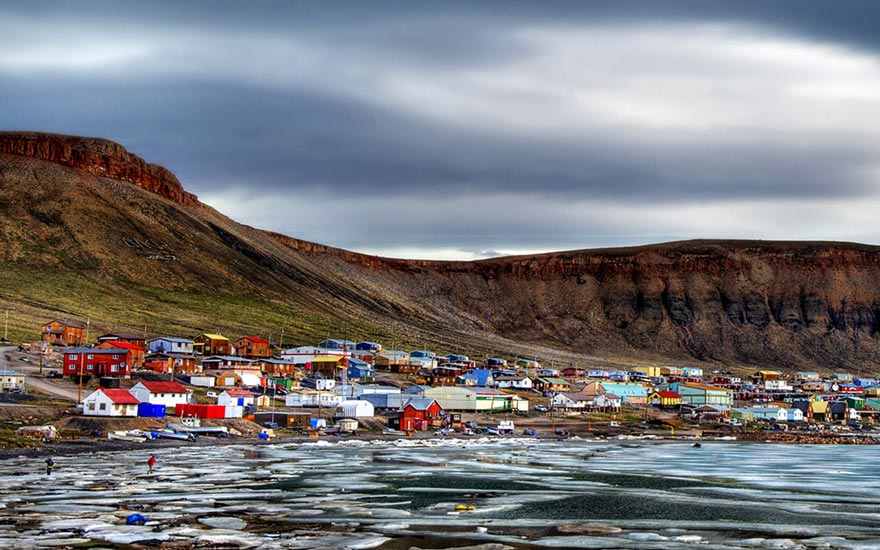Fort Simpson is a village in the Dehcho Region of the Northwest Territories. The community is located on an island at the confluence of the Mackenzie and Liard Rivers, both trade routes for the Hudson’s Bay Company and the native Dene people of the area. Fort Simpson the gateway to the scenic South Nahanni River and the Nahanni National Park Reserve.
Edmonton
Edmonton is the capital of Alberta and is the province’s second-largest city. Located on the North Saskatchewan River, it is North America’s northernmost city with a metropolitan population over one million. Edmonton is a cultural and governmental hub in Western Canada: known as the Festival City, it hosts a variety of world-class festivals year-round. It is also home to North America’s largest mall, the West Edmonton Mall, and Fort Edmonton Park, Canada’s largest living history museum, as well as the Edmonton Eskimos and Edmonton Oilers sports franchises.
Clyde River
There is a special magic in the air around Clyde River. Its Inuktitut name, Kangitugaapik meaning ‘nice little inlet’, belies its stunning beauty and its importance to Inuit for nearly 2000 years. Here is where Inuit and Norse Vikings had first contact around 1000 AD, long before the British explorers and the whalers arrived. Here you will find a mystical beauty in a wonderful, abundant land. You can travel with local guides deep in the fiords and soak in the majesty of the peaks.
Essential experiences include:
- Immersing yourself in stunning scenery and wildlife with expert local guides who will share a millennium of accumulated history, and take you through deep fords and mountains
- Scaling world-famous climbing cliffs for the very experienced mountain climbers
- Experiencing ancient Inuit culture and visiting local elders at the Piqqusilirivvik Inuit Cultural School
Located on the eastern coast of Baffin Island, Clyde River has become known for both preservation of Inuit culture and the majestic cliffs of the many fiords and mountains in the area.
The abundance of wildlife in the area has made the Clyde River area an important hunting ground for Inuit for nearly 2000 years. Unlike many other regions of Nunavut, Clyde River’s first contact with Europeans was not with British explorers and whalers, but rather Norse Vikings around 1000 AD. These early visitors called the area ‘Helluland’.
The modern community was formed around the Hudson’s Bay Company trading post, which was opened in 1924. In 1962, the Canadian Government created the Federal Day School, offering education to the Inuit in the area.
The community was founded on hunting and trapping, and today this tradition continues. The importance of hunting and Inuit culture led to the Government of Nunavut to create the Piqqusilirivvik Inuit Cultural School in 2011. This school provides young Inuit with the opportunity to immerse themselves in traditional hunting, sewing, and Inuit cultural activities.
You may come to Clyde River for the spectacular scenery, but it is the deep rooted culture and knowledge of local people that will make your journey complete. These expert hunters and seamstresses provide the context for your experience. Listen to the whispers of generations of elders welcoming all comers to this special place.
Kinngait (Cape Dorset)
Kinngait (Cape Dorset) is world-renowned for its Inuit art produced by its sculptors and drawing artists. Also known as Kinngait, meaning mountains in Inuktitut, learn about the land, culture and history of Nunavut through its stunning and thoughtful art. The iconic images expressed through printmaking, drawings, and sculptures have become world famous and were grown from the imagination of Kinngait artists. These images have made the beauty of the land and the people of Kinngait familiar globally with the many who love fine Inuit art.
Essential Kinngait experiences include:
- Visit the West Baffin Eskimo Cooperative, studio of globally renowned artists such as Kenojoak Ashevak, Pitseolak Ashoona, Annie Pootoogook, Peter Pitseolak. See current artists at work in the studios and visit the store
- Make the short journey to the ancient Thule, Dorset and Inuit archeological sites at nearby Mallikjuaq Territorial Park
- Visit over 100 ancient Inuksuit at the National Historic Site, Inuksugasait or Enukso Point, on the Foxe Peninsula
History
Inuit have congregated in the area for over 3000 years, drawn by the wildlife that provided the necessities of life. The ancient Dorest people are referred to as ‘Tuniit’ or ‘Sivullirmiut’ in Inuktitut and historians believe that the Dorset Culture people were perhaps the first North Americans ever encountered by Europeans who visited Baffin Island sometime before 1000 AD. The Dorset people became extinct by 1500 AD, however mystical traces of them are still visible while hiking Mallikjuaq or Dorset Island.
As with many other Nunavut communities, the Hudson’s Bay Company chose to build a trading post at Kinngait because of the trapping skills of the local Inuit. This post was constructed in 1913 and was followed in 1938 by the opening of a Roman Catholic Mission that was later closed in 1960.
The construction of the local Anglican mission was not by British clergy, but by local Inuit. In 1953 Inuit Anglicans constructed a church that still stands today.
The community is picturesque and will reward those who explore the nearby environment with a lifetime of Arctic memories. Nearby, Inuksugasait or Inukshuk or Enukso Point is an area of strong current and beautiful landscape of rugged and smooth areas of granite. It is an old camping ground of many Inukshuks but throughout time have been destroyed by bears and weather. The remains are there and quite a few Inukshuks are still standing since hundreds of years. Elder’s from Kinngait say it is a sacred ground where there has been a lot of activity of shamanism and other gatherings in the past.
Arts and Culture
Renowned for its groundbreaking Inuit prints and carvings, Kinngait offers an experience rich in nature and the arts.. Kinngait is world-renown for its printmaking, drawings, and carvings. Many acclaimed artists draw inspiration from the breathtaking landscape that is dotted with caribou on the nearby hills, and marine life of seals, walruses, beluga whales and sea birds.
Founded in 1959, the West Baffin Eskimo Co-operative is home to the beautiful works of Kinngait artists. Known as the most artistic community in Canada with almost a quarter of the labour force employed in the arts sector, Kinngait is the ‘Capital of Inuit Art’.
Activities and Wildlife
Visiting Kinngait includes a trek to the nearby Mallikjuaq Island, where many forms of Arctic wildlife, including herds of caribou, pods of seals, walrus, beluga whales, and polar bears live. Local guides will show you how the Inuit have lived for centuries through hunting and fishing. With their guidance, you can experience the wealth of the sea and land.
Cambridge Bay
Cambridge Bay, in Inuktitut ‘Ikalutuuttiaq’, means ‘good fishing place’, has been a gathering place for Inuit for over 4000 years. Today, Cambridge Bay continues to welcome Inuit and visitors alike, embracing the traditions of the past while building for the future. It represents the best of Nunavut: a strong connection to the land and wildlife a history welcoming visitors, and, a proud leader in Arctic science and technology research.
Explore Cambridge Bay to discover both the past and the future. Archaeological sites reveal ancient Inuit campsites and signs of the first European explorers. In contrast, Cambridge Bay is also home to military installations and the Canadian High Arctic Research Station, where scientists conduct research on polar science and technology. Essential Cambridge Bay experiences include:
- Experiencing the land and viewing muskox herds at nearby Ovayok Territorial Park
- Fish for abundant Arctic char, considered a ‘green’ and sustainable seafood
- Explore ancient Inuit campsites and the relics of the European search for the Northwest Passage
Cambridge Bay is the administrative and business centre of the Kitikmeot Region. It is also the centre for world class research throughout the Arctic. Nestled among rolling hills and tundra, Cambridge Bay is located on Victoria Island and is an important stop for cruises and private ships traversing the Northwest Passage.
History
In Cambridge Bay you can feel the echoes of the long search for the Northwest Passage. European contact began in 1839 and grew steadily. as the quest for the passage heated up. Norwegian explorer, Roald Amundsen’s ship, the ‘Maud’ sank into the harbour in Cambridge Bay and its exposed hull has been has been a local landmark for eight decades. This wreck was salvaged in 2016 and returns to Norway for its final step of conservation and preservation. Nonetheless, you can still feel the presence of Maud, after having rested on the seabed for 85 years.
The military has maintained a presence in Cambridge Bay since 1947 with the construction of a large LORAN (long range navigation) tower. This was followed in 1955 by the construction of a “Distant Early Warning Line (DEW Line)” base in the community. This sentinel still stands tall as a vital part of the North Warning System, controlled by the Canadian and United States Military. It remains operational today and as part of the joint Canada and US Warning System.
Activities
Inuit have lived in the Cambridge Bay area for 4000 years as it continues to be an excellent hunting and fishing spot. Today you can still enjoy Arctic char fishing, a ‘green’ and sustainable seafood. Travel to nearby Ovayok Territorial Park, an area that has been vital to local Inuit life for centuries. The park has numerous hiking trails and camping spots, allowing you to immerse yourself in the habitat of a muskox herd.
Arctic Bay
Arctic Bay is the third most northerly community in Canada. The hamlet itself is located on a south-facing gravel beach surrounded by majestic hills. This is where Arctic Bay derives its Inuktitut name, Ikpiarjuk, which translates as “bag” or “pocket” referring to the way the town site is nearly surrounded by protective hills.
Located at the entrance to Sirmilik National Park, Arctic Bay is a traditional Inuit community nestled between mountains and ocean. Arctic Bay, also known as ‘Ikpiarjuk’ in Inuktitut, meaning ‘The Pocket’, has an archeological and oral history showing that Inuit have inhabited the area for thousands of years. Today, Arctic Bay is also home to many of Nunavut’s finest photographers, capturing the stunning landscapes of mountains and the ocean. Some essential Arctic Bay experiences include:
- Paddling, hiking and dog sledding
- Viewing marine wildlife – narwhal and beluga whales
- Experiencing Inuit culture, arts, and traditions
- Stunning landscape photography
When you close your eyes and imagine the Arctic, you are likely picturing the hamlet of Arctic Bay. Nestled snugly amidst stunning mountains, Arctic Bay is a traditional community heavily reliant on hunting, fishing, and tourism, It provides visitors with a wide range of Arctic experiences- Inuit culture and tradition, rare Arctic wildlife, and awe-inspiring scenery.
Located at the northern tip of Baffin Island and at the entrance to Sirmilik National Park, the region is known for outdoor adventures including: paddling, hiking and dog sledding. Community members are pleased to share their local knowledge, gained over thousands of years, to get up close and personal with beluga and narwhal and the powerful polar bear.
Archaeological and oral history show that Inuit have inhabited the area for over 2000 years. Hunting in the area has long drawn nomadic groups of Inuit to the area.
The community as it stands today was established with the opening of a Hudson’s Bay Company trading post in 1933 to conduct trade, followed by the opening of an Anglican mission in 1937.
In 1941 a joint Canada-US weather station was built here that operated for twenty years. It is the oldest building still standing. The first school was built in 1959 and this brought the slow movement of Inuit off the land and into the community on a permanent basis.
Arctic Bay is close to the former mining community of Nansivik, which at one point was a self-contained town until the mine closed in 2002. The Nansivik site still has port infrastructure for large military vessels.


